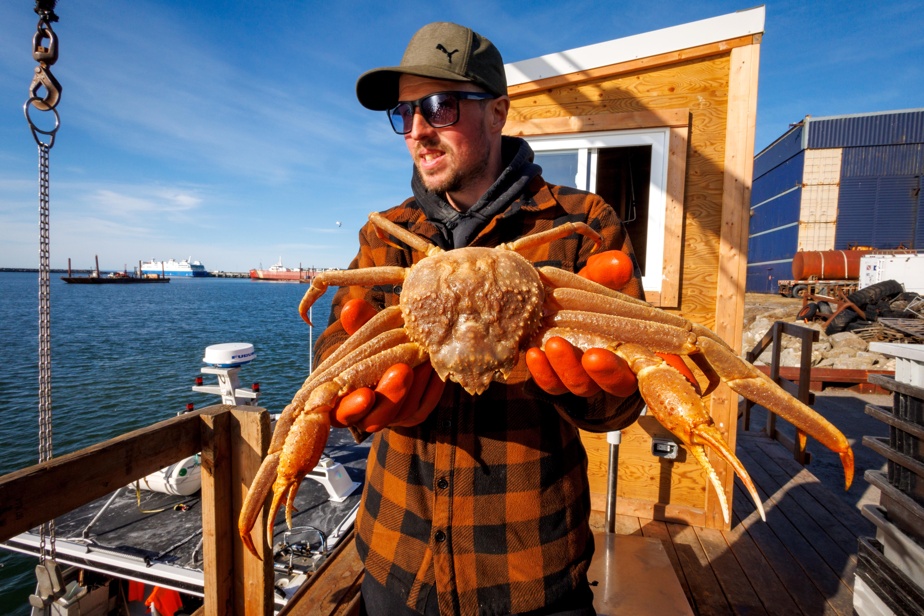(Matane) Pierre-Nicolas Tanguay-Lévesque and Franky Dugas have always had their sea legs: they grew up on a boat. They fish for crab and turbot from the port of Matane. They bought their respective father’s fishing licenses several years ago. Except that turbot stocks follow shrimp stocks: it therefore looks very bad this year.
“These are two species that deal quite a bit together and who stand in the same depths, the same waters, explains Pierre-Nicolas Tanguay-Lévesque. They do not necessarily respond well to warming water. »
The allocation of quotas for turbot will be revealed in ten days, on May 15, but the captains already know that this fishing will not be profitable this year, because they expect very limited catch permissions.
The turbot is caught smaller and smaller. He grows less. It has something to do with his food or maybe climate change.
Pierre-Nicolas Tanguay-Lévesque, fisherman
Crab season is good, from a certain point of view: there are lots of small crustaceans – and females with eggs. Excellent news for fishermen looking to the future; a little less for customers of fishmongers who find their crabs very small…

PHOTO ALAIN ROBERGE, THE PRESS
Other Quebec fishermen work directly with fishmongers elsewhere, on the North Shore in particular, but it is a new business model for Pierre-Nicolas and Franky who want to ensure the sustainability of their businesses.
With fluctuations in stocks and prices, the two young fishermen opted for a business model that they had not yet tried: their catches no longer go to the factory, they now deal directly with a fishmonger, Bernard Lauzier, from Kamouraska. Their catches therefore remain entirely on the Quebec market, which delights them; the model is more complicated, but more rewarding, they say.

PHOTO ALAIN ROBERGE, THE PRESS
When the fishermen arrive, an employee of Poissonnerie Lauzier waits for them at the port of Matane and collects the crabs.
The fishermen and the fishmonger have made adjustments so that they all get the most out of it: as crab sells more on weekends, Pierre-Nicolas and Franky agree to adapt their schedule accordingly or even change their area fishing according to commercial demand. In return, Bernard Lauzier buys their entire quota, with a premium. If he has too many crabs, the trader must sell them to distributors.
Crabs are small
-

PHOTO ALAIN ROBERGE, THE PRESS
“The first one waiting after the crab in the spring is myself,” says Bernard Lauzier, owner of the homonymous fishmonger in Kamouraska – and now a second branch, in Rivière-du-Loup.
-

PHOTO ALAIN ROBERGE, THE PRESS
The crab being smaller, sales are lower, because customers buy it with a quantity in mind, and not a weight: they are used to taking three sections per person.
-

PHOTO ALAIN ROBERGE, THE PRESS
By purchasing directly from the fisherman, it is the fishmonger’s employees who arrange the shellfish. In the middle of the fishing season, things are buzzing with activity at Lauzier. The owner is constantly solicited by his team who must negotiate the price of certain fish and then collect the catch when the fisherman’s boat returns to port.
-

PHOTO ALAIN ROBERGE, THE PRESS
“People don’t really want small crab,” says Bernard Lauzier, “they want big crab, even if it’s not always full. » In a bag that contained 10 crabs last year, fishmongers can put 15 or 16 this year.
-

PHOTO ALAIN ROBERGE, THE PRESS
In late April and early May, crab sales are much lower than at the beginning of the season.
1/5
“Four years ago, I decided to dive,” says Bernard Lauzier, met in his fish market in Kamouraska. This partnership makes his life (a little) easier: rather than calling several boats to negotiate his purchases, he speaks to a single fisherman for his crab and receives the crustacean at the desired time.
This year, sales are less good, for several reasons, explains Bernard Lauzier: the economic situation and the quality of the crab which, being smaller, attracts fewer customers. “Last year, it wasn’t a good season, but two years ago, we had our best season in history. »
Consumers remember: we went from a season where prices were very high to another where crab was offered cheaply, in the spring of 2023. Excessive price fluctuations which ultimately harm entire chain, says Bernard Lauzier. “It was extremely hard,” he said. It killed the market. »

PHOTO ALAIN ROBERGE, THE PRESS
The fisherman Roger Ouellette comes to sell his catches at the Poissonnerie Lauzier. In the photo he is holding an Atlantic halibut.
Halibut or halibut?
Please note: Greenland halibut, which is actually turbot, should not be confused with Atlantic halibut, this large fish from the Gulf of St. Lawrence whose stocks are healthy. Which makes it a sustainable choice at the fish store.
